Cryptocurrency, often referred to as crypto, stands as a groundbreaking technology with roots tracing back to at least 1983 and was formally introduced in 2009. Functioning as a decentralized form of currency, it relies on a digital ledger, commonly known as blockchain, to meticulously record transactions and ownership details for each unit.
Characterizing the crypto market as a complex and intricate system would be an understatement, given the myriad processes occurring behind the scenes. Fortunately, even for a novice, creating a cryptocurrency token or coin is possible. In reality, the process of creating your own cryptocurrency is quite straightforward.
This article will guide you through the steps of creating your cryptocurrency, from selecting the platform and developing blockchain components to the promotional strategies for your product. Let’s dive into the topic of how to make your own cryptocurrency!
Understanding cryptocurrency creation
A cryptocurrency is a decentralized digital currency that utilizes encryption techniques to regulate the creation of currency units and verify fund transfers. Unlike traditional currencies issued by central banks, cryptocurrencies operate on a decentralized network supported by a technology called blockchain.
Individuals holding cryptocurrencies possess the ability to transfer these digital assets seamlessly between crypto wallets and blockchain addresses. Furthermore, they can exchange them for traditional fiat currencies or engage in cryptocurrency trading.
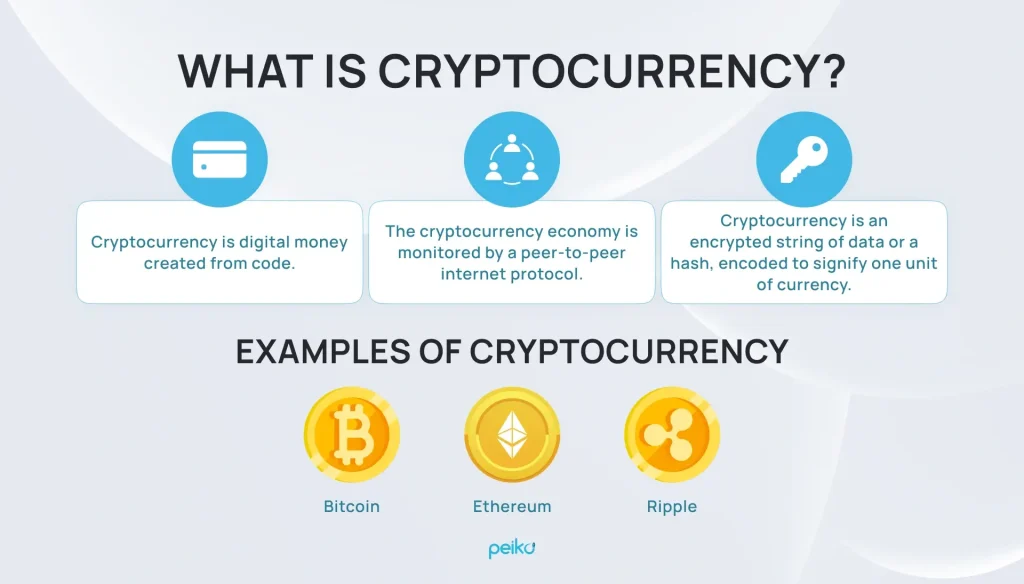
As of 2024, Statista reported a count exceeding 10,000 cryptocurrencies, although this number fluctuates. Most of these cryptocurrencies are inactive, but those that are at the top receive all the revenue.
How to make your own cryptocurrency? First, let’s figure out what blockchain is and why cryptocurrencies are needed for it to work.
Why does a blockchain need cryptocurrency?
Blockchain, an essential component of cryptocurrencies, operates as a decentralized peer-to-peer (P2P) network consisting of interconnected data blocks. These blocks play a pivotal role in recording transaction information chronologically, adhering to a protocol for communication between nodes, and validating the addition of new blocks. The data recorded in blocks remains unalterable without simultaneous changes to all subsequent blocks.
Cryptocurrency is essential for a blockchain as it serves as an incentive for users to verify and secure transactions. It rewards miners or validators who maintain the network’s integrity by confirming and documenting each transaction.
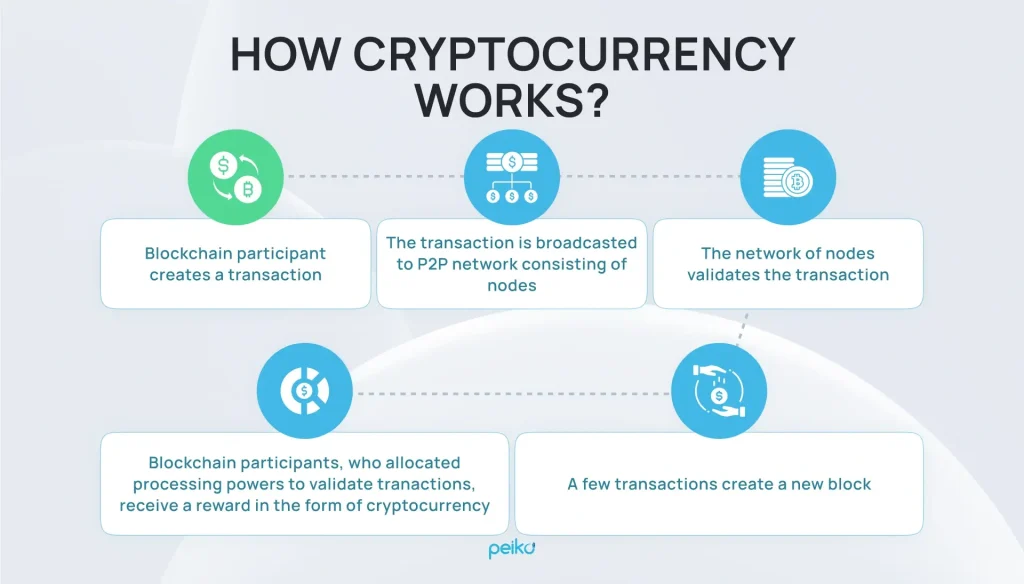
Coin vs token
Cryptocurrencies can be categorized into two broad subtypes: coins and tokens. While both fall under the umbrella of cryptocurrencies, there is a notable distinction between a coin and a token.
A coin operates autonomously on its dedicated blockchain, serving as the exclusive platform for all transactions. Examples of coins include Bitcoin, Ethereum, and Neo, each functioning on a distinct blockchain. How to create a coin? This process necessitates the initial step of establishing your blockchain infrastructure.
In contrast, if you are looking for how to create a cryptocurrency token, it functions atop an existing blockchain infrastructure, such as Corda or Ethereum, leveraging its capabilities to verify and secure transactions. Tokens often serve purposes akin to smart contracts, representing a spectrum of entities from tangible objects to digital services.
If you want to dive deeper into the topic of how to create a crypto coin and token and understand their differences better, watch the video below.
Whitepaper
If you want to create new cryptocurrency, you definitely need a whitepaper. It is a comprehensive document that explains the technical framework, objectives, and implementation strategy of a cryptocurrency project. It is commonly published by project creators to offer transparency and attract potential investors by detailing how the project works and its development plan.
What is the process of creating new cryptocurrency coins? Below we will consider the main points to take into account at the beginning of development.
What to consider before starting?
Before you embark on the journey of how to create a new cryptocurrency, several crucial factors must be considered if you want a successful launch.
Is it legal in your country?
Want to create new cryptocurrency? The first step is to understand the legal environment surrounding cryptocurrencies in your jurisdiction. Regulations differ widely from country to country, so it’s essential to ensure that your project complies with local laws and avoids any legal complications.
At Peiko, we will help you navigate the regulatory landscape and ensure your cryptocurrency project complies with the legal requirements in your jurisdiction.
What is the purpose and use case of my cryptocurrency?
While the creation of a cryptocurrency can be an enjoyable endeavor, its real-world app within a business context demands the formulation of a strategic plan. It is imperative to define the problem your product aims to address and the specific audience it targets.
Engaging professional business analysis services can prove instrumental in navigating this crucial phase. At Peiko, we will provide you with a well-defined strategic plan that becomes the cornerstone of your cryptocurrency venture.
How long does it take to create a cryptocurrency? When you discuss your idea with us, we will offer estimates about the cost and time of its creation, according to your requirements.
Which consensus mechanism should I use and why?
Every cryptocurrency relies on a foundational blockchain platform, ensuring the meticulous recording and widespread distribution of each transaction across the blockchain. This establishes a robust system of accountability, rendering it impervious to external hacking attempts, fraudulent activities, or unauthorized alterations to the digital ledger.
In the realm of blockchains, the consensus mechanism plays a pivotal role in providing this functionality. In simpler terms, a consensus mechanism functions as a communication protocol that dictates whether a specific transaction is deemed valid within a blockchain network.
There are different consensus mechanisms, each with its specific characteristics. The choice you make here significantly impacts your cryptocurrency’s security, efficiency, and decentralization.
Here’s a rundown of some prevalent consensus mechanisms:
- PoW (proof of work): Proof of work involves miners engaging in a competition to solve complex mathematical puzzles, and the miner who successfully accomplishes this task first earns the privilege of adding a block. While PoW is a widely adopted method, it necessitates significant energy resources and computational power.
- PoS (proof of stake): PoS designates the creator of a new block based on their ownership or stake in the cryptocurrency. Recognized for its energy efficiency, PoS encourages users to retain their coins.
- DPoS (delegated proof of stake): A variant of proof of stake, DPoS involves users voting for a limited number of delegates with block-producing authority, streamlining the process and enhancing efficiency.
- PoA (proof of authority): PoA relies on a group of pre-approved individuals or nodes with recognized identities to validate transactions and build new blocks. While efficient, PoA sacrifices a level of decentralization.
We have mentioned just some of the consensus mechanisms, but they are various. Here is a video with a detailed description of all of them.
Should I issue a coin or a token?
When deciding whether to issue a coin, stablecoin or a token, consider the underlying blockchain. A coin operates on its own blockchain, while a token is built on an existing platform like Ethereum. Coins provide more independence but require more resources, while tokens are easier to create but depend on another network for functionality.
Tokenomics
Tokenomics refers to the economic structure of your cryptocurrency, including the total supply, distribution methods, and incentives for participants. It’s vital to plan how tokens/coins will be distributed, how you will handle inflation, and how to create coin with lasting value. A solid tokenomics model ensures the long-term viability and attractiveness of your cryptocurrency.
Choosing a blockchain platform (for token creation)
The next crucial step in our guide on how to make a cryptocurrency revolves around choosing the most fitting blockchain platform. The platform you opt for lays the groundwork for the functionality and features of your cryptocurrency. Here’s a glimpse of some standout and versatile blockchain platforms widely embraced in the realm of cryptocurrency creation:
- Ethereum: Acclaimed for its smart contract capabilities, Ethereum stands as a pioneer, empowering developers to forge decentralized applications (dApps) and tailor-made tokens.
- BNB Chain: BNB Smart Chain is an integral part of the Binance ecosystem, distinguished by its swift and cost-effective transactions. It emerges as a preferred choice for projects tapping into the BNB network.
- Tron: Prioritizing scalability and high throughput, Tron serves as a platform for constructing decentralized applications and hosting digital content.
- Solana: Acknowledged for its high-performance blockchain, Solana strives for expeditious and economical transactions, rendering it suitable for a diverse array of applications.
- Polygon: Formerly known as Matic, Polygon operates as a layer 2 scaling solution for Ethereum, amplifying its speed and curbing transaction costs.
- Stellar: Tailored for swift and efficient cross-border transactions, Stellar excels in facilitating payments and token issuance.
The choice of the platform hinges on your cryptocurrency’s specific needs, encompassing transaction speed, cost dynamics, and project nature.
The Peiko team is here to help you.

Designing the cryptocurrency
In this section, we’ll delve into the critical elements of what is the process of creating new cryptocurrency coins, including defining its objectives and developing core blockchain components.
Build necessary blockchain components
Creating the necessary components marks the tangible phase of breathing life into your blockchain architecture. Here’s an outline of the pivotal components:
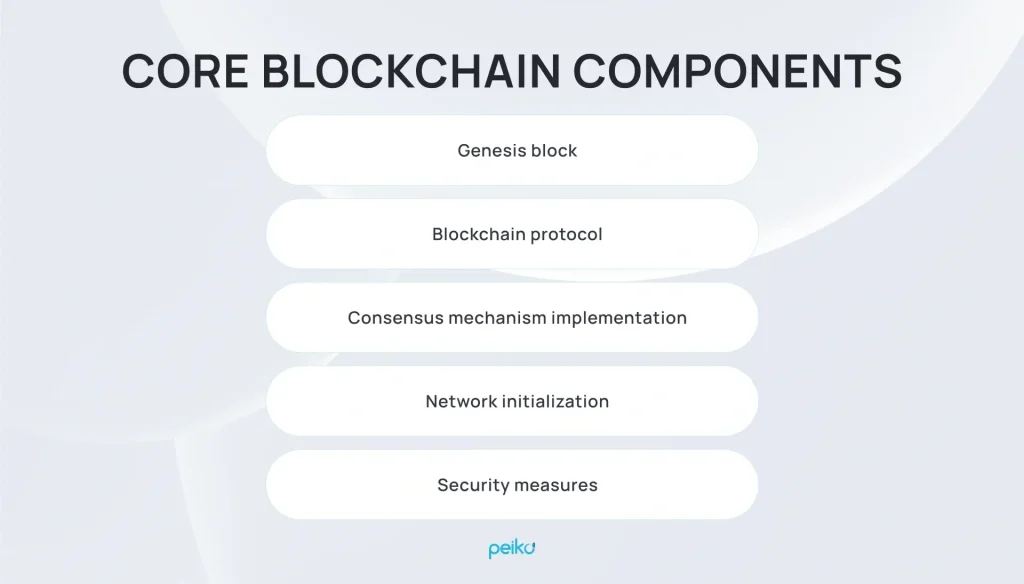
Genesis block: Craft the inaugural block of your blockchain, often referred to as the genesis block. Define distinctive attributes, including the timestamp and the initial set of transactions.
Nodes: Engineer the nodes that will actively engage in the network. Implement requisite software and configurations to empower nodes for communication and transaction validation.
Blockchain protocol: Construct the fundamental blockchain protocol dictating how transactions integrate into the ledger. Specify the regulations governing consensus achievement and the preservation of the blockchain’s integrity.
Consensus mechanism implementation: Translate the chosen consensus mechanism from the design phase into executable code. Ensure nodes can harmonize to validate transaction legitimacy and add new blocks.
Network initialization: Commence the network by interconnecting nodes and establishing communication channels. Execute preliminary tests to verify nodes synchronize and function as intended.
Security measures: It is important to deploy security measures to fortify against potential threats, embracing cryptographic encryption and secure communication protocols.
Documentation: Detail the architecture, components, and protocols for future reference.
Provide lucid documentation for developers contributing to or engaging with your blockchain.
Implement smart contracts (if applicable)
Smart contracts are self-executing agreements where the agreement’s terms are coded directly into the system. Functioning on blockchain technology, these contracts independently execute actions when specific predefined conditions are met. Essentially, they embody programmable scripts designed to streamline, authenticate, or enforce the negotiation and fulfillment of a contract, eliminating the necessity for intermediaries.
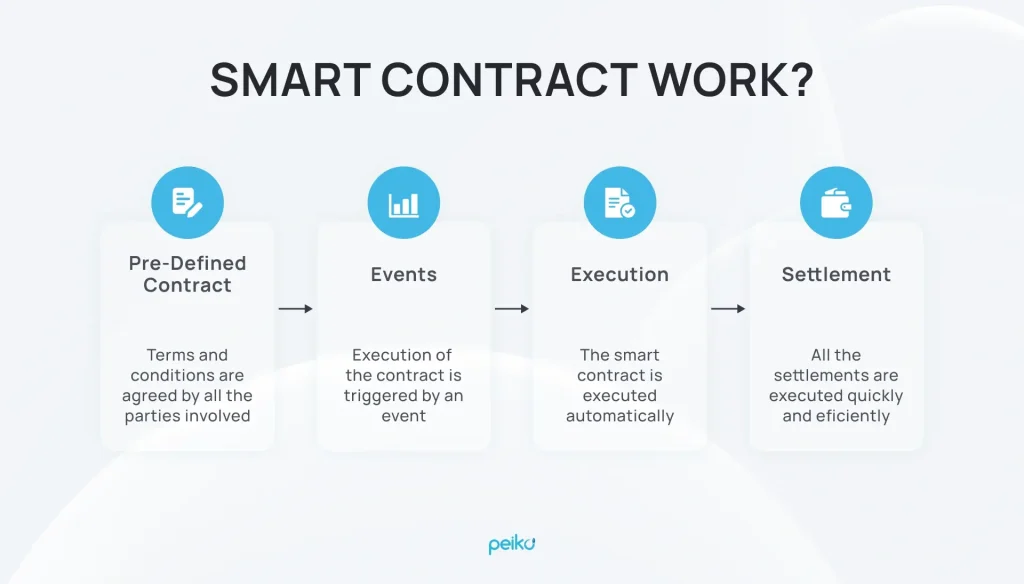
Let’s consider how to implement smart contracts on your network:
- To begin, articulate the logic and functionalities encapsulated within each smart contract, defining the precise conditions that warrant their execution within the blockchain.
- Select an appropriate programming language tailored to your chosen blockchain platform, considering Solidity for Ethereum or other languages specific to the platform.
- Program each smart contract to execute under specific conditions, aligning with transaction confirmations, designated dates, or other criteria relevant to their intended purpose.
- Prioritize security throughout the implementation, adhering to industry best practices, conducting rigorous testing, and addressing potential vulnerabilities to ensure their robustness and integrity.
- Before deploying smart contracts on the live network, subject them to extensive testing on a controlled environment like a testnet. This ensures that any identified issues are resolved without compromising the security of the live blockchain.
- Upon successful testing, proceed to deploy your smart contracts on the mainnet, activating their functionalities within the live blockchain environment.
- Ensure seamless interaction between smart contracts and other components of your cryptocurrency ecosystem, such as wallets, nodes, and APIs (application programming interfaces). This integration is vital for the cohesive functionality of the cryptocurrency.
- Document the specifics of your smart contracts, elucidating their purpose, execution conditions, and interactions, facilitating understanding and ongoing maintenance.
Set up nodes and network
It is another vital stage in our tutorial on how to create your own cryptocurrency. Every node represents an individual computing unit actively engaged in the blockchain network. Its responsibilities encompass storing a comprehensive replica of the entire blockchain and verifying transactions. Nodes are crucial in transaction validation, consensus forging, and overall network resilience.
Here’s an extensive guide on forging nodes and fine-tuning the network:
Commence node configuration
Define the blockchain’s essence – whether it is a public or private blockchain – and ascertain the optimal number of nodes for a fluid and effective network.
Define blockchain character
Delve into the nature of your blockchain – be it public, private, or consortium. Each archetype presents unique advantages and considerations. Align your choice with the project’s aspirations and requirements.
Deploy nodes strategically
Disseminate the configured nodes strategically across the network, ensuring an equitable distribution that upholds decentralization principles. Every node contributes to transaction validation and the blockchain’s integrity.
Integrate consensus
Whether opting for proof of work (PoW), proof of stake (PoS), or an innovative alternative, ensure harmonious integration in alignment with the cryptocurrency’s objectives.
Fortify node security
Want to create new cryptocurrency? Implement robust security measures to shield nodes from potential threats. Enforce encryption, adopt secure key management practices, and adhere to best security practices, enhancing the overall fortification of nodes within the network.
Streamline inter-node communication
Establish efficient communication protocols that facilitate seamless data exchange, synchronization, and validation processes between nodes. A well-defined communication framework ensures the smooth functioning of the decentralized network.
Consider scalability demands
Anticipate and plan for scalability requirements tailored to your cryptocurrency. Design the network infrastructure with scalability at its core, enabling it to handle an increasing volume of transactions and participants gracefully.
Provide thorough documentation
Document the intricacies of node configuration, network setup, and any specific parameters relevant to the decentralized network. Comprehensive documentation serves as a compass for understanding and maintaining the network’s integrity over time.
Ensure continuous vigilance
Regularly monitor the performance metrics of nodes and the overarching network. Implement agile measures to address emerging issues promptly, safeguarding the stability and reliability of your cryptocurrency’s decentralized infrastructure.
Legal and regulatory considerations
Navigating the legal landscape is an essential aspect of launching a cryptocurrency. If you are looking for how to create cryptocurrency, you should ensure compliance with regulatory requirements and consider the legal implications:
Regulatory compliance
Thoroughly research and adhere to regulatory requirements related to cryptocurrencies in your target jurisdictions. Seek legal counsel to ensure compliance with data protection, financial, and anti-money laundering regulations.
According to Coin Dance, a Bitcoin statistics site, the cryptocurrency is abandoned in the following countries: Pakistan, Bangladesh, Vietnam, Algeria, Bolivia, Afghanistan, and Macedonia. Take this aspect into account.
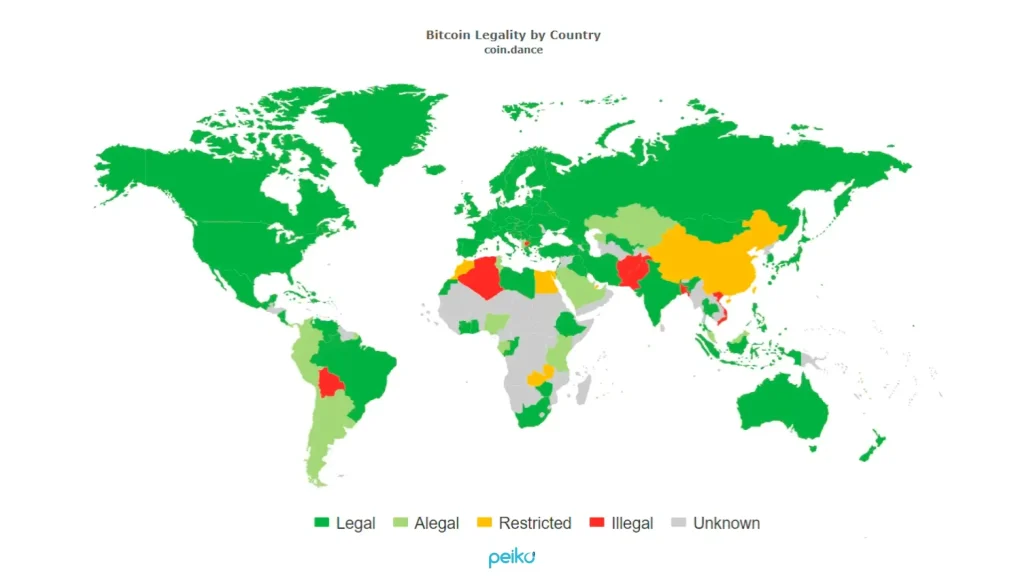
Legal documentation
Prepare legal documentation comprising privacy policies, terms of service, and disclaimers. Clearly communicate the rights and responsibilities of users and outline the legal framework governing your cryptocurrency.
Community transparency
You should maintain transparency with your community regarding legal considerations. Clearly communicate compliance efforts and any legal challenges your cryptocurrency may face. Establish trust by keeping the community informed.
Maintaining and growing the cryptocurrency
This step in our guide to how to create a new cryptocurrency is all about putting your cryptocurrency in the spotlight and fostering its growth within the digital ecosystem.
Here are important factors to focus on as you work to sustain and expand your cryptocurrency:
Security and regular updates
Consistently updating your cryptocurrency’s code is vital to fix any security flaws and improve the overall system. Prioritizing security helps prevent potential hacks, fraud, and technical issues, safeguarding your users and preserving trust in your project.
Ongoing development
Continuously enhance your cryptocurrency by adding new features, improving scalability, and optimizing its performance. Staying innovative ensures your project remains competitive and aligns with the needs of users over time.
Forming strategic partnerships
Collaborate with businesses, blockchain projects, or other networks to integrate your cryptocurrency into practical applications. Strategic partnerships can boost your cryptocurrency’s credibility and expand its use across various industries.
Marketing and user education
Promote your cryptocurrency through targeted campaigns to attract new users and raise awareness. Educate potential users about the unique features and pros of your cryptocurrency. Provide resources, tutorials, and informative content to empower users and encourage their involvement.
Building an engaged community
Focus on creating a vibrant and engaged community around your cryptocurrency. Foster communication, address user concerns, and create a sense of belonging. A strong community contributes to the long-term success of your cryptocurrency.
Our experts will implement your idea.

The Peiko team is your top choice for creating crypto solutions
Our specialists are masters of custom software development services and blockchain technology. We seamlessly navigate the complexities of distributed ledger systems, ensuring functionality, security, and scalability.
Peiko’s team emerges as a reliable and accomplished partner for those who want to appear in the intricate landscape of crypto projects, standing out as leaders in innovation and success in the realm of cryptocurrency ventures. We provide many services, such as cryptowallet, cryptocurrency exchange development, and many others.
Peiko’s proficiency in crafting crypto solutions is exemplified by Bitcoin Additional, a feature-rich mobile crypto wallet designed for convenience and functionality. This user-friendly cryptocurrency wallet facilitates seamless transfers to contacts, accommodates various coins, and includes an offline payment function.

The design prioritizes simplicity and functionality, ensuring a positive experience for both active crypto-users and those new to the cryptocurrency landscape.
We also implemented the most straightforward and convenient process for sending and requesting coins, streamlining the user experience. Moreover, the team has devised comprehensive security measures to protect transactions and user data, ensuring a safe space for users to interact with their cryptocurrency assets.

The impact of Bitcoin Additional extends beyond its functionalities:
Community building
The creation of a robust community of users speaks to the success and popularity of Bitcoin Additional. This community fosters engagement, discussions, and shared experiences among cryptocurrency enthusiasts.
Integration with Quan2um agglomeration
Bitcoin Additional has seamlessly integrated into the Quan2um agglomeration, emerging as a headliner in the realm of mobile wallets. This integration enhances its visibility and utility within the broader crypto ecosystem.
Active user base
As of today, the application boasts thousands of active users, attesting to its widespread adoption and appeal within the cryptocurrency community. This userbase is a testament to the effectiveness and resonance of Bitcoin Additional in meeting the diverse needs of crypto enthusiasts.
Conclusion
In summary, developing a cryptocurrency requires careful planning and understanding of the key steps involved. By clearly defining your goals, choosing the right tools, and considering security measures, you can create cryptocurrency project that will succeed. Keep in mind the changing landscape of decentralized finance and technology trends.
With this step-by-step guide, we have provided a straightforward resource for anyone looking to venture into the world of creating their own cryptocurrency.
If you need help to create new cryptocurrency or any blockchain solution, turn to us. We will answer your question on how long does it take to create a cryptocurrency, provide you with the cost estimates, and implement all your boldest ideas into life!










